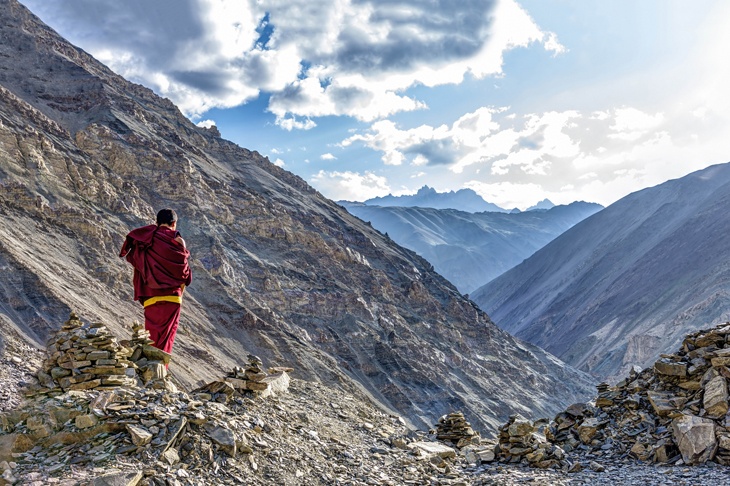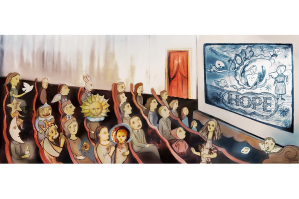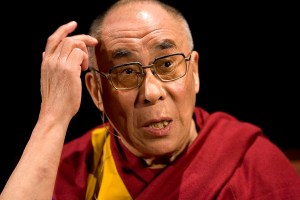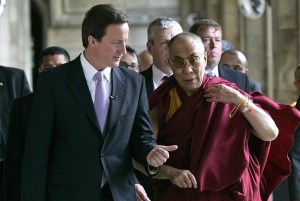Blessings from Beijing
will inform readers who know little about Tibet, and those who know a great deal will discover more. Both groups will be surprised. The newcomers especially will be disabused of any belief that Tibetans were always non-violent, deeply spiritual and unworldly.
Tibetanists and advanced students will learn that, decades after the Chinese conquest of Tibet in 1950 and the escape of the Dalai Lama in 1959, the diaspora of about 130,000 Tibetan refugees, battered by decades of Chinese oppression and ‘soft’ propaganda, is riven by confusion. Some cling to their hope that Tibet will again be sovereign and they will be able to return to their homeland.
Greg Bruno, modestly described on the book’s flyleaf as a journalist, is actually an expert on many aspects of Tibet’s history, Chinese oppression and persecution — ironically termed ‘blessings’ by the Dalai Lama — and most of all the conditions of the Tibetan diaspora and the deepening despair that rends it. ‘Many Tibetan refugees, pushed away by time, boredom, globalisation and a soft-power war with China, are moving on.’
Bruno has never visited Tibet in the many years he has been concentrating on the ‘blessings’ and the diaspora, but he has travelled around its borders and throughout the world to discover the condition of the refugees and to listen to their opinions and the judgments of their leaders, including the Dalai Lama. One of his most striking characteristics is his modesty; he never claims to know a thing about Tibet and the refugees that he has not learned first-hand. What he knows and what he suspects are kept distinct. But he sums up brilliantly: ‘The Communist party of China is the source of the Tibetan malaise; but Tibetans’ self-inflicted wounds have made China’s strategy more effective.’ From 2010, for example, Beijing blocked escape routes from Tibet except for Tibetans rich enough to fly out, and the Nepalese king denied them settlement.
Bruno tellingly describes and details China’s centuries of relations with Tibet, reaching back to the seventh, when a powerful Tibetan ruler captured a major Chinese city, forcing the emperor to present a royal princess to Lhasa as a placatory gesture. Over the years, depending on China’s power, there were sometimes Chinese officials stationed in Lhasa; but up to 1911 the Chinese emperors and the Dalai Lamas — the present one is the 14th — existed as temporal and spiritual equals. From 1911 to 1950, Tibet was essentially independent; and even after Mao took power, he treated Tibet with some respect for a time, and even negotiated with the young Dalai — whose personal account of those contacts is fascinating — before suggesting, almost off-handedly, that of course Buddhism would have to be abolished.
Indeed, as Bruno makes plain, religion remains at the heart of Beijing’s determination to subdue and transform Tibet. For Tibetans, what makes their society and culture special and unequalled is the selection and enthronement of tulkus, ‘reincarnated’ lamas. This ceremony, with all its implications, is now being taken over by Beijing. The most spectacular example occurred in 1995, when the 10th Panchen Lama, the second most important religious figure in Tibet, died. The Dalai Lama announced that his successor was a six-year-old boy. Beijing declared this to be spurious: the boy and his family have vanished, and Beijing installed its own Panchen with full traditional religious honours. He has been declared the senior religious leader in Tibet — where Tibetans ignore him.
Of course Beijing will name its own 15th Dalai Lama when the present one dies, although he has claimed (even to me) that his doctors at Harvard predict he will live well past his 100th birthday. But although he has retired as Tibet’s leading political and religious figure, his successor, a Harvard graduate, is only feebly respected; and as Bruno painstakingly shows, many Tibetans, already in some despair, fear their struggle to exist as a special people will alter or cease when this Dalai Lama is gone.
What has changed in recent years, Bruno writes, and has so deeply undermined the confidence of Tibetans with Tibet and abroad, is the nature of China’s ‘blessings’ — which I saw in bloodthirsty force in the 1980s. Such violence — always in reserve in case of a sudden uprising in Tibetan territories, where many devout and patriotic Buddhists have burned themselves to death — is now overshadowed by the effective Chinese pressure on world leaders and poor countries either to ignore the Dalai Lama and his champions or lose economic ties with Beijing. From Norway to Washington to the Vatican the Dalai Lama can make no high-level contacts. No. 10 declares: ‘We have turned the page on the Dalai Lama.’ Blessings indeed.


















